Abstract
Brody's disease, i.e., sarcoplasmic reticulum (SR) Ca(2+)-dependent Mg(2+)-ATPase (Ca(2+)-ATPase) deficiency, is a rare inherited disorder of skeletal muscle function. Pseudo-myotonia is the most important clinical feature. SR Ca(2+)-ATPase and Ca2+ homeostasis are examined in m. quadriceps and/or cultured muscle cells of controls and 10 patients suffering from Brody's disease. In both m. quadriceps and cultured muscle cells of patients, the SR Ca(2+)-ATPase activity is decreased by approximately 50%. However, the concentration of SR Ca(2+)-ATPase and SERCA1 are normal. SERCA1 accounts for 83 and 100% of total SR Ca(2+)-ATPase in m. quadriceps and cultured muscle cells, respectively. This implies a reduction of the molecular activity of SERCA1 in Brody's disease. The cytosolic Ca2+ concentration ([Ca2+]i) at rest and the increase of [Ca2+]i after addition of acetylcholine are the same in cultured muscle cells of controls and patients. The half-life of the maximal response, however, is raised three times in the pathological muscle cells. Addition of dantrolene or verapamil after the maximal response accelerates the restoration of the [Ca2+]i in these muscle cells. The differences in Ca2+ handling disappear by administration of dantrolene or verapamil concomitantly with acetylcholine. The reduced Ca2+ re-uptake from the cytosol presumably due to structural modification(s) of SERCA1 may explain the pseudo-myotonia in Brody's disease. Single cell measurements suggest a beneficial effect of dantrolene or verapamil in treating patients suffering from Brody's disease.
Full text
PDF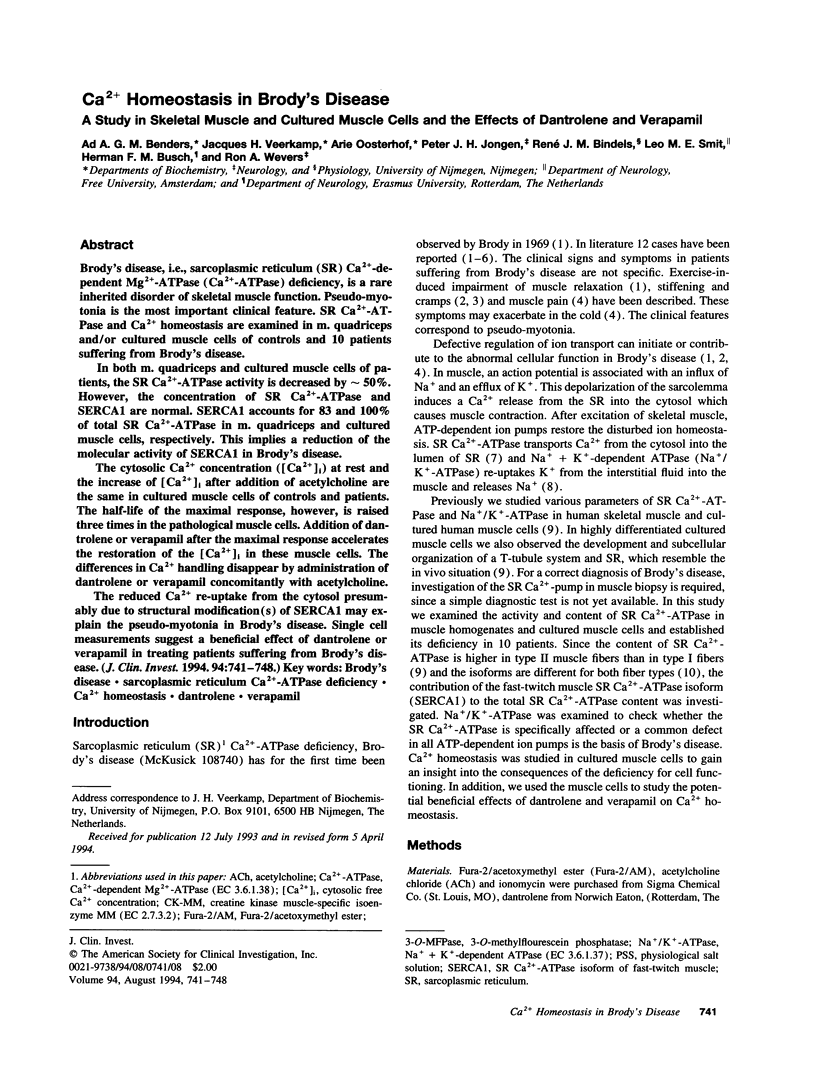
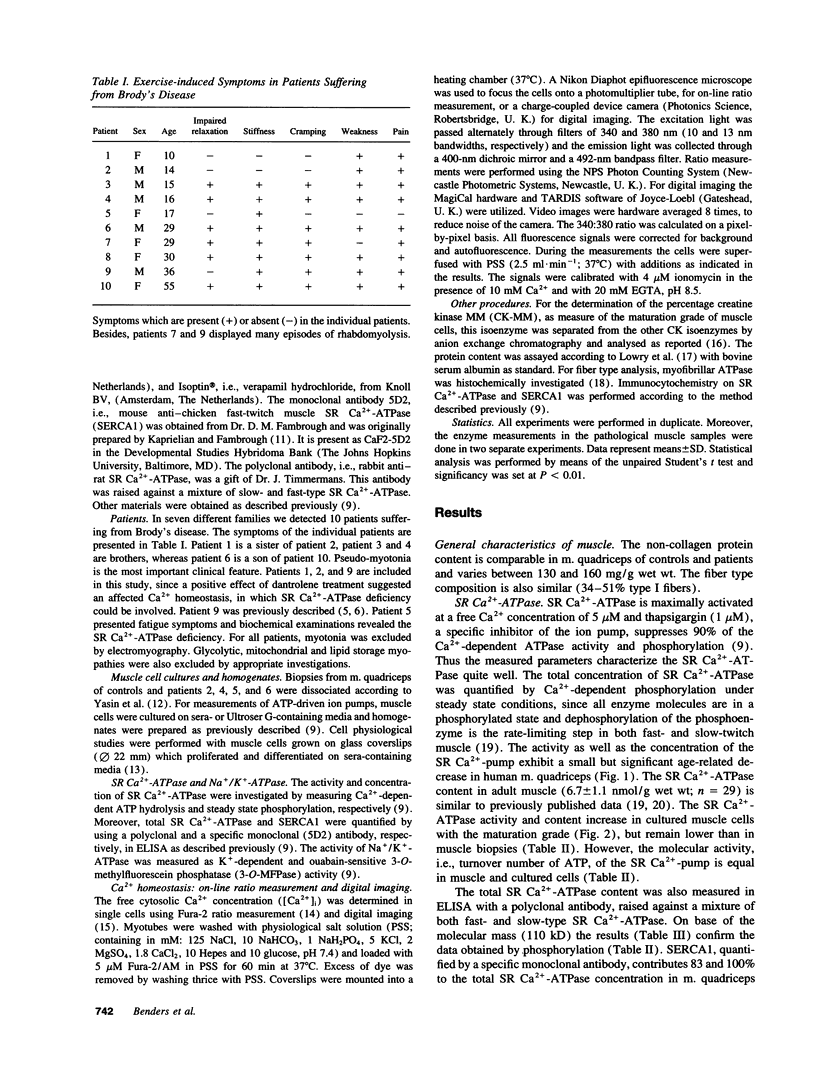
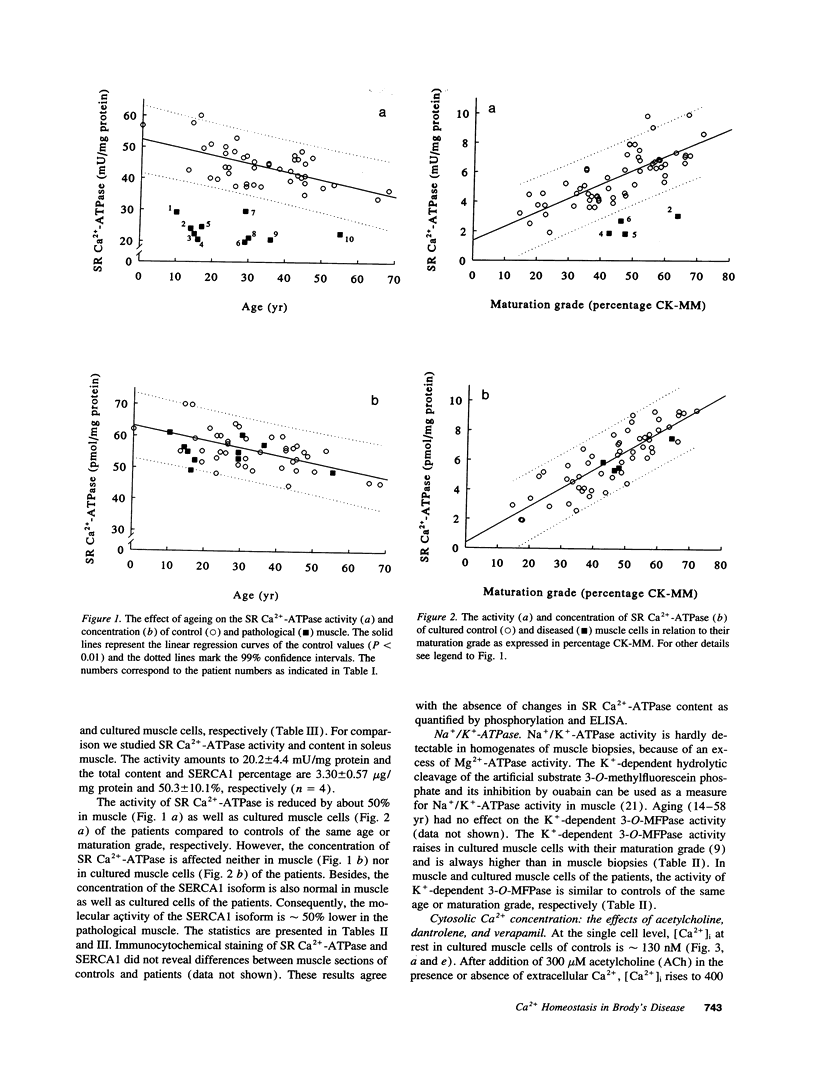
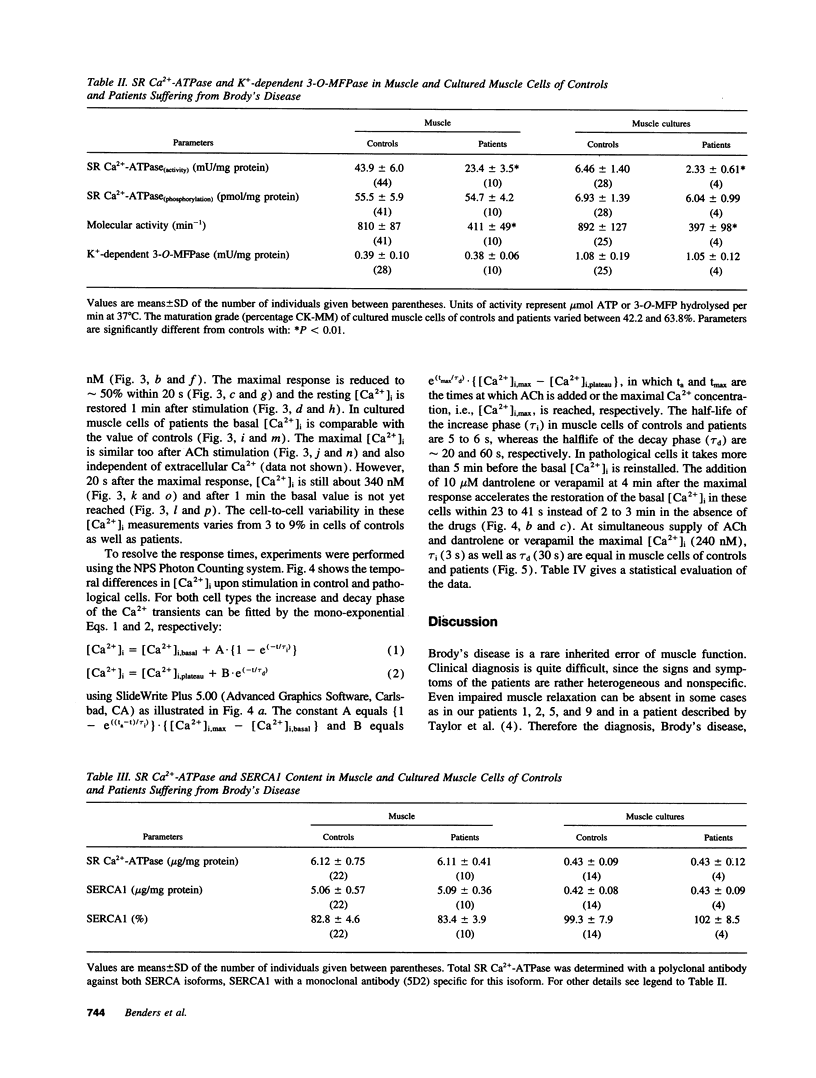
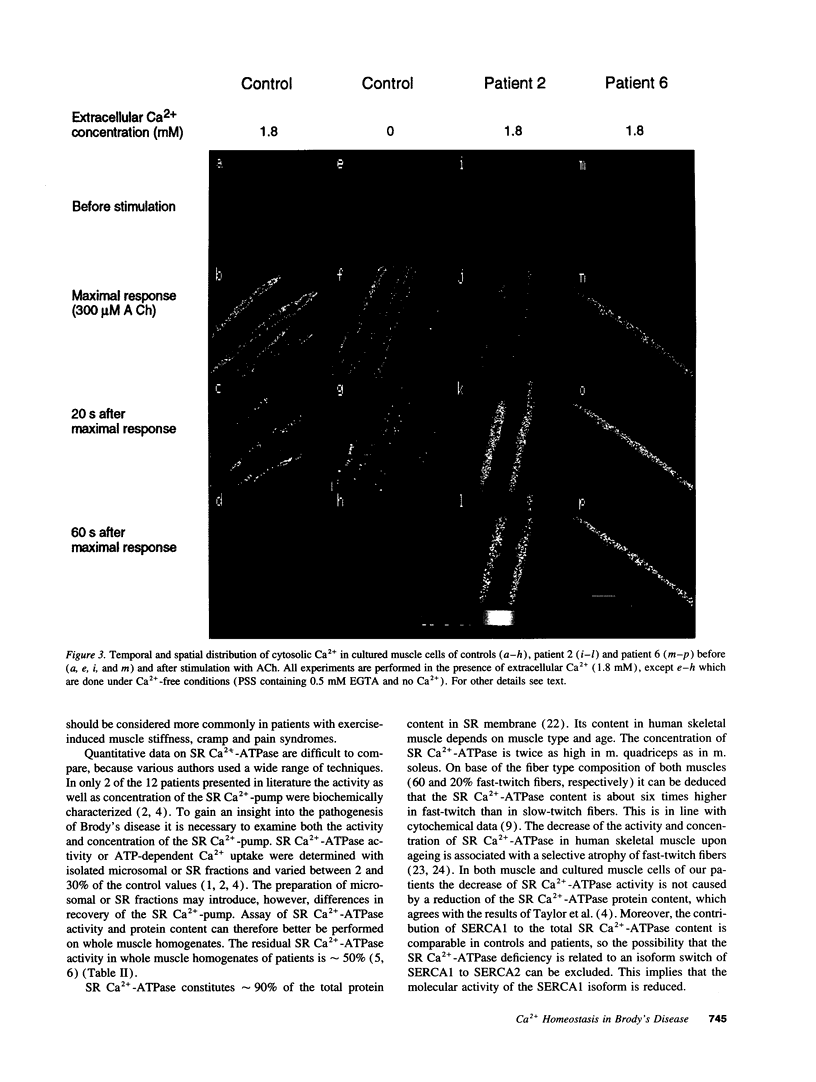
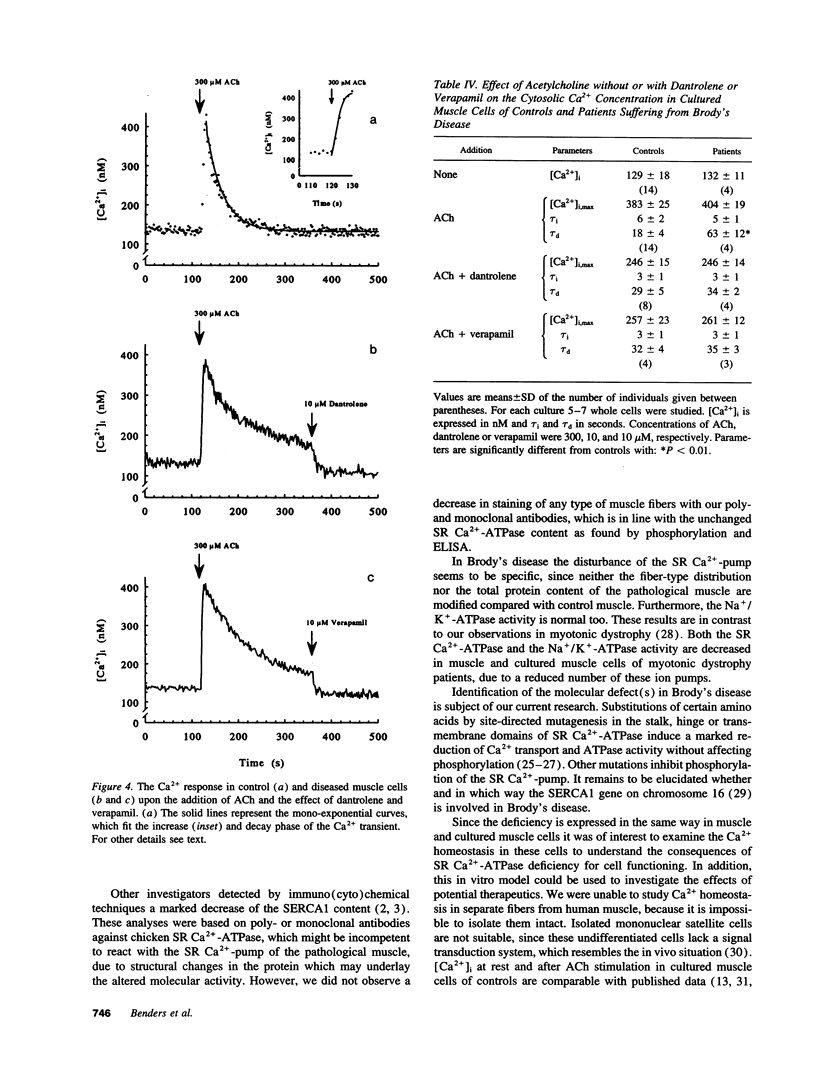
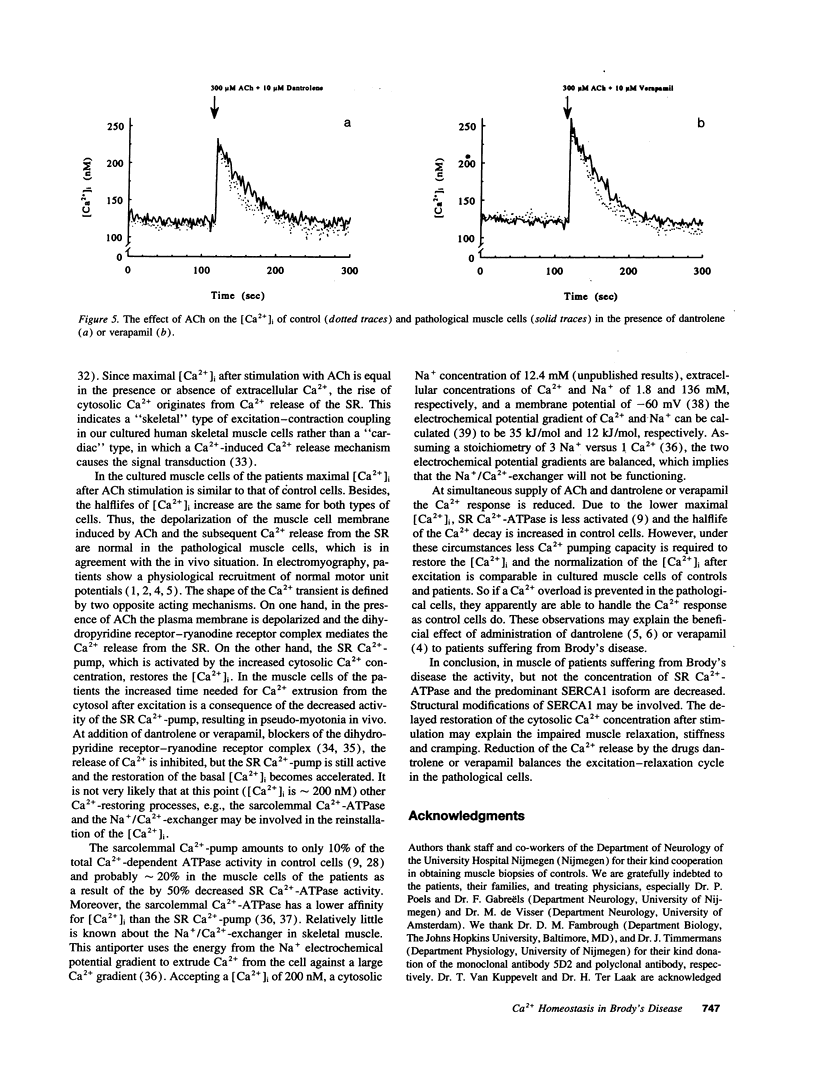
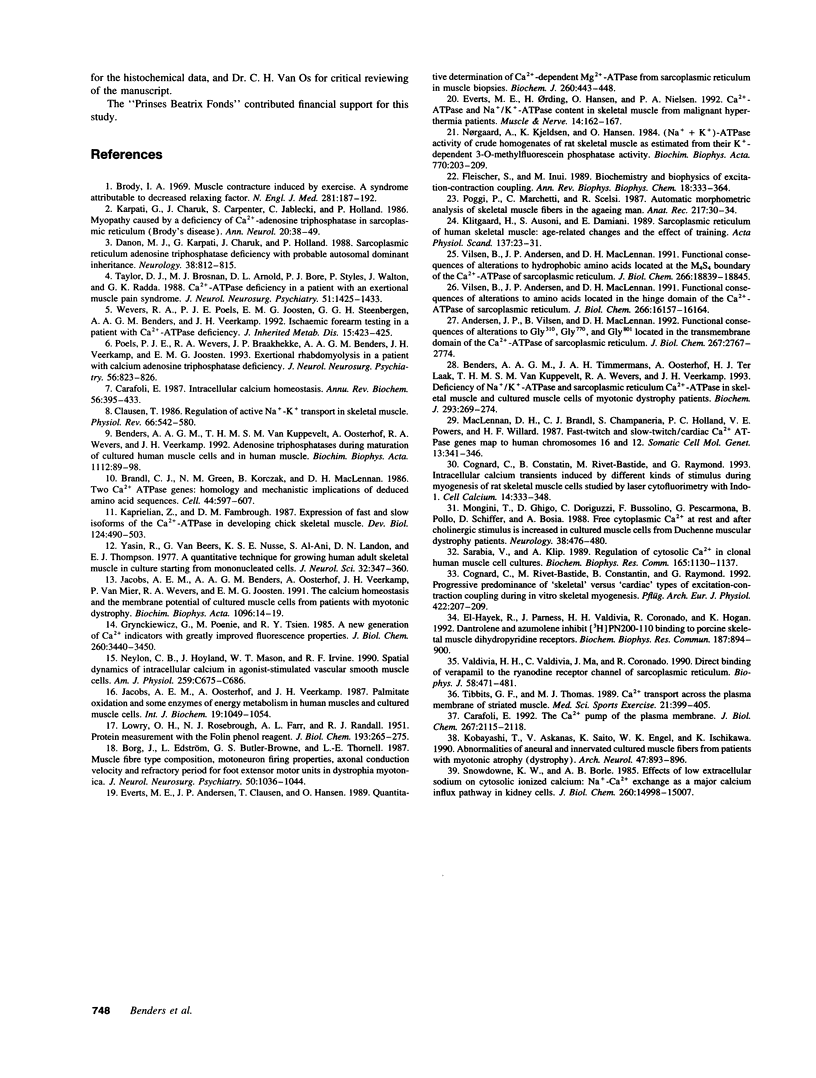
Images in this article
Selected References
These references are in PubMed. This may not be the complete list of references from this article.
- Andersen J. P., Vilsen B., MacLennan D. H. Functional consequences of alterations to Gly310, Gly770, and Gly801 located in the transmembrane domain of the Ca(2+)-ATPase of sarcoplasmic reticulum. J Biol Chem. 1992 Feb 5;267(4):2767–2774. [PubMed] [Google Scholar]
- Benders A. A., Timmermans J. A., Oosterhof A., Ter Laak H. J., van Kuppevelt T. H., Wevers R. A., Veerkamp J. H. Deficiency of Na+/K(+)-ATPase and sarcoplasmic reticulum Ca(2+)-ATPase in skeletal muscle and cultured muscle cells of myotonic dystrophy patients. Biochem J. 1993 Jul 1;293(Pt 1):269–274. doi: 10.1042/bj2930269. [DOI] [PMC free article] [PubMed] [Google Scholar]
- Benders A. G., van Kuppevelt T. H., Oosterhof A., Wevers R. A., Veerkamp J. H. Adenosine triphosphatases during maturation of cultured human skeletal muscle cells and in adult human muscle. Biochim Biophys Acta. 1992 Nov 23;1112(1):89–98. doi: 10.1016/0005-2736(92)90258-n. [DOI] [PubMed] [Google Scholar]
- Borg J., Edström L., Butler-Browne G. S., Thornell L. E. Muscle fibre type composition, motoneuron firing properties, axonal conduction velocity and refractory period for foot extensor motor units in dystrophia myotonica. J Neurol Neurosurg Psychiatry. 1987 Aug;50(8):1036–1044. doi: 10.1136/jnnp.50.8.1036. [DOI] [PMC free article] [PubMed] [Google Scholar]
- Brandl C. J., Green N. M., Korczak B., MacLennan D. H. Two Ca2+ ATPase genes: homologies and mechanistic implications of deduced amino acid sequences. Cell. 1986 Feb 28;44(4):597–607. doi: 10.1016/0092-8674(86)90269-2. [DOI] [PubMed] [Google Scholar]
- Brody I. A. Muscle contracture induced by exercise. A syndrome attributable to decreased relaxing factor. N Engl J Med. 1969 Jul 24;281(4):187–192. doi: 10.1056/NEJM196907242810403. [DOI] [PubMed] [Google Scholar]
- Carafoli E. Intracellular calcium homeostasis. Annu Rev Biochem. 1987;56:395–433. doi: 10.1146/annurev.bi.56.070187.002143. [DOI] [PubMed] [Google Scholar]
- Carafoli E. The Ca2+ pump of the plasma membrane. J Biol Chem. 1992 Feb 5;267(4):2115–2118. [PubMed] [Google Scholar]
- Clausen T. Regulation of active Na+-K+ transport in skeletal muscle. Physiol Rev. 1986 Jul;66(3):542–580. doi: 10.1152/physrev.1986.66.3.542. [DOI] [PubMed] [Google Scholar]
- Cognard C., Constantin B., Rivet-Bastide M., Raymond G. Intracellular calcium transients induced by different kinds of stimulus during myogenesis of rat skeletal muscle cells studied by laser cytofluorimetry with Indo-1. Cell Calcium. 1993 Apr;14(4):333–348. doi: 10.1016/0143-4160(93)90054-a. [DOI] [PubMed] [Google Scholar]
- Cognard C., Rivet-Bastide M., Constantin B., Raymond G. Progressive predominance of 'skeletal' versus 'cardiac' types of excitation-contraction coupling during in vitro skeletal myogenesis. Pflugers Arch. 1992 Nov;422(2):207–209. doi: 10.1007/BF00370424. [DOI] [PubMed] [Google Scholar]
- Danon M. J., Karpati G., Charuk J., Holland P. Sarcoplasmic reticulum adenosine triphosphatase deficiency with probable autosomal dominant inheritance. Neurology. 1988 May;38(5):812–815. doi: 10.1212/wnl.38.5.812. [DOI] [PubMed] [Google Scholar]
- Everts M. E., Andersen J. P., Clausen T., Hansen O. Quantitative determination of Ca2+-dependent Mg2+-ATPase from sarcoplasmic reticulum in muscle biopsies. Biochem J. 1989 Jun 1;260(2):443–448. doi: 10.1042/bj2600443. [DOI] [PMC free article] [PubMed] [Google Scholar]
- Everts M. E., Ording H., Hansen O., Nielsen P. A. Ca(2+)-ATPase and Na(+)-K(+)-ATPase content in skeletal muscle from malignant hyperthermia patients. Muscle Nerve. 1992 Feb;15(2):162–167. doi: 10.1002/mus.880150206. [DOI] [PubMed] [Google Scholar]
- Fleischer S., Inui M. Biochemistry and biophysics of excitation-contraction coupling. Annu Rev Biophys Biophys Chem. 1989;18:333–364. doi: 10.1146/annurev.bb.18.060189.002001. [DOI] [PubMed] [Google Scholar]
- Grynkiewicz G., Poenie M., Tsien R. Y. A new generation of Ca2+ indicators with greatly improved fluorescence properties. J Biol Chem. 1985 Mar 25;260(6):3440–3450. [PubMed] [Google Scholar]
- Jacobs A. E., Benders A. A., Oosterhof A., Veerkamp J. H., van Mier P., Wevers R. A., Joosten E. M. The calcium homeostasis and the membrane potential of cultured muscle cells from patients with myotonic dystrophy. Biochim Biophys Acta. 1990 Nov 14;1096(1):14–19. doi: 10.1016/0925-4439(90)90006-b. [DOI] [PubMed] [Google Scholar]
- Jacobs A. E., Oosterhof A., Veerkamp J. H. Palmitate oxidation and some enzymes of energy metabolism in human muscles and cultured muscle cells. Int J Biochem. 1987;19(11):1049–1054. doi: 10.1016/0020-711x(87)90305-3. [DOI] [PubMed] [Google Scholar]
- Kaprielian Z., Fambrough D. M. Expression of fast and slow isoforms of the Ca2+-ATPase in developing chick skeletal muscle. Dev Biol. 1987 Dec;124(2):490–503. doi: 10.1016/0012-1606(87)90502-1. [DOI] [PubMed] [Google Scholar]
- Karpati G., Charuk J., Carpenter S., Jablecki C., Holland P. Myopathy caused by a deficiency of Ca2+-adenosine triphosphatase in sarcoplasmic reticulum (Brody's disease). Ann Neurol. 1986 Jul;20(1):38–49. doi: 10.1002/ana.410200108. [DOI] [PubMed] [Google Scholar]
- Klitgaard H., Ausoni S., Damiani E. Sarcoplasmic reticulum of human skeletal muscle: age-related changes and effect of training. Acta Physiol Scand. 1989 Sep;137(1):23–31. doi: 10.1111/j.1748-1716.1989.tb08717.x. [DOI] [PubMed] [Google Scholar]
- Kobayashi T., Askanas V., Saito K., Engel W. K., Ishikawa K. Abnormalities of aneural and innervated cultured muscle fibers from patients with myotonic atrophy (dystrophy). Arch Neurol. 1990 Aug;47(8):893–896. doi: 10.1001/archneur.1990.00530080077014. [DOI] [PubMed] [Google Scholar]
- LOWRY O. H., ROSEBROUGH N. J., FARR A. L., RANDALL R. J. Protein measurement with the Folin phenol reagent. J Biol Chem. 1951 Nov;193(1):265–275. [PubMed] [Google Scholar]
- MacLennan D. H., Brandl C. J., Champaneria S., Holland P. C., Powers V. E., Willard H. F. Fast-twitch and slow-twitch/cardiac Ca2+ ATPase genes map to human chromosomes 16 and 12. Somat Cell Mol Genet. 1987 Jul;13(4):341–346. doi: 10.1007/BF01534928. [DOI] [PubMed] [Google Scholar]
- Mongini T., Ghigo D., Doriguzzi C., Bussolino F., Pescarmona G., Pollo B., Schiffer D., Bosia A. Free cytoplasmic Ca++ at rest and after cholinergic stimulus is increased in cultured muscle cells from Duchenne muscular dystrophy patients. Neurology. 1988 Mar;38(3):476–480. doi: 10.1212/wnl.38.3.476. [DOI] [PubMed] [Google Scholar]
- Neylon C. B., Hoyland J., Mason W. T., Irvine R. F. Spatial dynamics of intracellular calcium in agonist-stimulated vascular smooth muscle cells. Am J Physiol. 1990 Oct;259(4 Pt 1):C675–C686. doi: 10.1152/ajpcell.1990.259.4.C675. [DOI] [PubMed] [Google Scholar]
- Nørgaard A., Kjeldsen K., Hansen O. (Na+ + K+)-ATPase activity of crude homogenates of rat skeletal muscle as estimated from their K+-dependent 3-O-methylfluorescein phosphatase activity. Biochim Biophys Acta. 1984 Mar 14;770(2):203–209. doi: 10.1016/0005-2736(84)90131-7. [DOI] [PubMed] [Google Scholar]
- Poels P. J., Wevers R. A., Braakhekke J. P., Benders A. A., Veerkamp J. H., Joosten E. M. Exertional rhabdomyolysis in a patient with calcium adenosine triphosphatase deficiency. J Neurol Neurosurg Psychiatry. 1993 Jul;56(7):823–826. doi: 10.1136/jnnp.56.7.823. [DOI] [PMC free article] [PubMed] [Google Scholar]
- Poggi P., Marchetti C., Scelsi R. Automatic morphometric analysis of skeletal muscle fibers in the aging man. Anat Rec. 1987 Jan;217(1):30–34. doi: 10.1002/ar.1092170106. [DOI] [PubMed] [Google Scholar]
- Sarabia V., Klip A. Regulation of cytosolic Ca2+ in clonal human muscle cell cultures. Biochem Biophys Res Commun. 1989 Dec 29;165(3):1130–1137. doi: 10.1016/0006-291x(89)92720-4. [DOI] [PubMed] [Google Scholar]
- Snowdowne K. W., Borle A. B. Effects of low extracellular sodium on cytosolic ionized calcium. Na+-Ca2+ exchange as a major calcium influx pathway in kidney cells. J Biol Chem. 1985 Dec 5;260(28):14998–14507. [PubMed] [Google Scholar]
- Taylor D. J., Brosnan M. J., Arnold D. L., Bore P. J., Styles P., Walton J., Radda G. K. Ca2+-ATPase deficiency in a patient with an exertional muscle pain syndrome. J Neurol Neurosurg Psychiatry. 1988 Nov;51(11):1425–1433. doi: 10.1136/jnnp.51.11.1425. [DOI] [PMC free article] [PubMed] [Google Scholar]
- Tibbits G. F., Thomas M. J. Ca2+ transport across the plasma membrane of striated muscle. Med Sci Sports Exerc. 1989 Aug;21(4):399–405. [PubMed] [Google Scholar]
- Valdivia H. H., Valdivia C., Ma J., Coronado R. Direct binding of verapamil to the ryanodine receptor channel of sarcoplasmic reticulum. Biophys J. 1990 Aug;58(2):471–481. doi: 10.1016/S0006-3495(90)82392-4. [DOI] [PMC free article] [PubMed] [Google Scholar]
- Vilsen B., Andersen J. P., MacLennan D. H. Functional consequences of alterations to amino acids located in the hinge domain of the Ca(2+)-ATPase of sarcoplasmic reticulum. J Biol Chem. 1991 Aug 25;266(24):16157–16164. [PubMed] [Google Scholar]
- Vilsen B., Andersen J. P., MacLennan D. H. Functional consequences of alterations to hydrophobic amino acids located at the M4S4 boundary of the Ca(2+)-ATPase of sarcoplasmic reticulum. J Biol Chem. 1991 Oct 5;266(28):18839–18845. [PubMed] [Google Scholar]
- Wevers R. A., Poels P. J., Joosten E. M., Steenbergen G. G., Benders A. A., Veerkamp J. H. Ischaemic forearm testing in a patient with Ca(2+)-ATPase deficiency. J Inherit Metab Dis. 1992;15(3):423–425. doi: 10.1007/BF02435994. [DOI] [PubMed] [Google Scholar]
- Yasin R., Van Beers G., Nurse K. C., Al-Ani S., Landon D. N., Thompson E. J. A quantitative technique for growing human adult skeletal muscle in culture starting from mononucleated cells. J Neurol Sci. 1977 Jul;32(3):347–360. doi: 10.1016/0022-510x(77)90018-1. [DOI] [PubMed] [Google Scholar]
- el-Hayek R., Parness J., Valdivia H. H., Coronado R., Hogan K. Dantrolene and azumolene inhibit [3H]PN200-110 binding to porcine skeletal muscle dihydropyridine receptors. Biochem Biophys Res Commun. 1992 Sep 16;187(2):894–900. doi: 10.1016/0006-291x(92)91281-t. [DOI] [PubMed] [Google Scholar]



